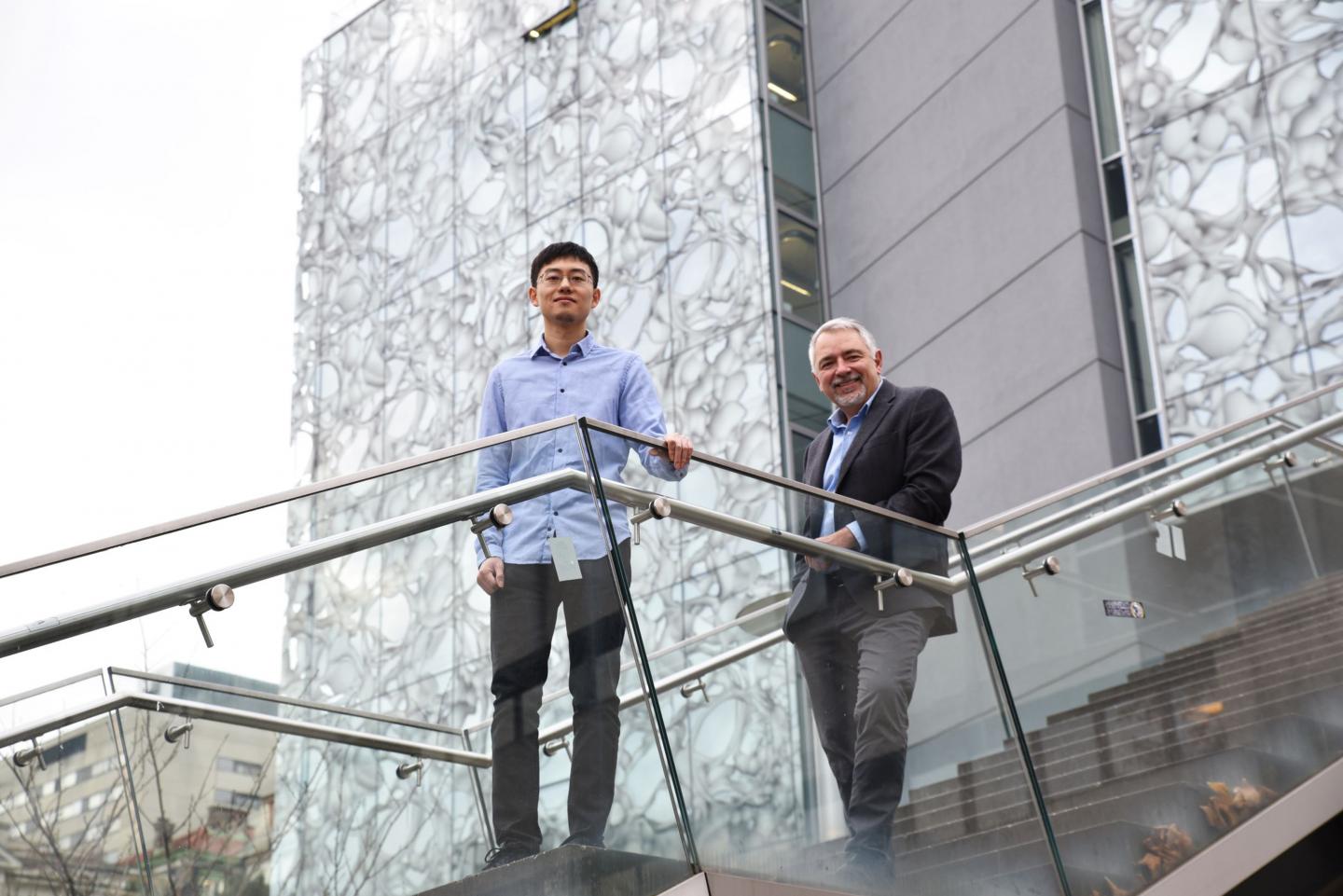Study introduces new therapeutic approach for the treatment of primary myelofibrosis

Credit: First author Ruochen Jia and Last author Robert Kralovics.
Patients with myeloproliferative neoplasm (MPN), a group of malignant diseases of the bone marrow, often have a carcinogenic mutated form of the calreticulin gene (CALR). Scientists of the research group of Robert Kralovics, Adjunct Principal Investigator at the CeMM Research Center for Molecular Medicine of the Austrian Academy of Sciences and group leader at the Medical University of Vienna, have now identified hematoxylin as a novel CALR inhibitor. The study, published in the renowned journal Blood, shows how hematoxylin compounds affect a specific domain of CALR and selectively kill those CALR mutant cells that have been identified as the cause of disease in MPN patients. The discovery has enormous therapeutic potential and gives hope for new treatment options.
In medicine, a group of malignant diseases of the bone marrow is known as myeloproliferative neoplasms. This special type of blood cancer is characterised by increased formation of blood cells, vulnerability to thrombosis and frequent transformation to acute leukaemia. In the laboratory of Robert Kralovics it was discovered as early as 2013 that carcinogenic mutations of the gene calreticulin (CALR) were frequently found in affected patients and are now used clinically as diagnostic and prognostic markers. The mechanism by which the mutated CALR functions as an oncogene, which can lead to myeloid leukaemia, has also been scientifically identified since then. The carcinogenic effect of CALR mutations is based on the interaction of the N-glycan binding domain (GBD) of CALR with the thrombopoietin receptor. Ruochen Jia from the research group of Robert Kralovics at CeMM was looking for a way to stop this interaction and prevent one of the growth advantages of CALR mutated cells. It became evident that a group of chemicals, most notably hematoxylin, can selectively kill mutated CALR cells. The results thus provide extremely valuable information for potential treatment approaches for myeloproliferative neoplasms.
Hematoxylin compounds kill CALR mutated cells
Robert Kralovics, head of the study, explains: “In our study we tried to identify small molecules that might block the interaction between the mutated CALR and the receptor.” The scientists used so-called in-silico docking studies for this purpose. “Basically, these are computer-based simulations of biochemical processes – virtual ‘screenings’ that enable increasingly accurate predictions,” says study author Ruochen Jia. The results showed a group of chemicals as binders for a specific domain of calreticulin, which selectively kill the mutated CALR cells. “Our data suggest that small molecules targeting the N-glycan binding domain of CALR can selectively kill CALR-mutated cells by disrupting the interaction between CALR and the thrombopoietin receptor and inhibiting oncogenic signal transmission,” said the study author. A hematoxylin compound proved to be particularly efficient. So far, hematoxylin has been used as a dye especially in histological staining processes.
Ray of hope for primary myelofibrosis therapy
“Our study demonstrates the enormous therapeutic potential of CALR inhibitor therapy,” says Kralovics. “The treatment of patients with primary myelofibrosis (PMF) continues to produce poor clinical outcomes. They have the clearest tendency to develop acute myeloid leukaemia. Since about one third of PMF patients have a CALR mutation, they could particularly benefit from the new therapeutic approach.”
###
The study “Hematoxylin binds to mutant calreticulin and disrupts its abnormal interaction with thrombopoietin receptor” was published in the journal Blood on 17 November 2020. DOI: https:/
###
Robert Kralovics has been Principal Investigator at CeMM since 2006 and a Group Leader at the Medical University of Vienna (MUV) since 2017. He earned his master’s degree in Molecular Biology and Genetics at Comenius University and his PhD in Genomics at the Institute of Biophysics of the Academy of Sciences of the Czech Republic. His post-doctoral work was based on the genetics of myeloproliferative disorders working with Josef Prchal at the University of Alabama in Birmingham, USA. In 2000, Robert joined Prchal’s group as Assistant Professor at Baylor College of Medicine in Houston. In 2001, he became project leader with Radek Skoda in Basel. Kralovics’ research interests are primarily in myeloproliferative neoplasms (MPNs) and in myeloid malignancies in general. His major achievements so far have been the identification of disease-causing mutations in the JAK2 kinase gene (V617F) in 2005 and in the calreticulin gene (CALR) in 2013. Using advanced genomic approaches, Robert Kralovics continues his research at CeMM and the MUV to identify new therapeutic strategies for MPN. His aim is understanding how genetic variability contributes to MPN and how it could be treated in a personalized manner.
The mission of CeMM Research Center for Molecular Medicine of the Austrian Academy of Sciences is to achieve maximum scientific innovation in molecular medicine to improve healthcare. At CeMM, an international and creative team of scientists and medical doctors pursues free-minded basic life science research in a large and vibrant hospital environment of outstanding medical tradition and practice. CeMM’s research is based on post-genomic technologies and focuses on societally important diseases, such as immune disorders and infections, cancer and metabolic disorders. CeMM operates in a unique mode of super-cooperation, connecting biology with medicine, experiments with computation, discovery with translation, and science with society and the arts. The goal of CeMM is to pioneer the science that nurtures the precise, personalized, predictive and preventive medicine of the future. CeMM trains a modern blend of biomedical scientists and is located at the campus of the General Hospital and the Medical University of Vienna. http://www.
Medical University of Vienna (MedUni Vienna) is one of the most traditional medical education and research facilities in Europe. With almost 8,000 students, it is currently the largest medical training centre in the German-speaking countries. With 5,500 employees, 26 departments and two clinical institutes, 12 medical theory centres and numerous highly specialised laboratories, it is also one of Europe’s leading research establishments in the biomedical sector.. http://www.
Media Contact
Anna Maria Schwendinger
[email protected]
Original Source
http://cemm.
Related Journal Article
http://dx.


